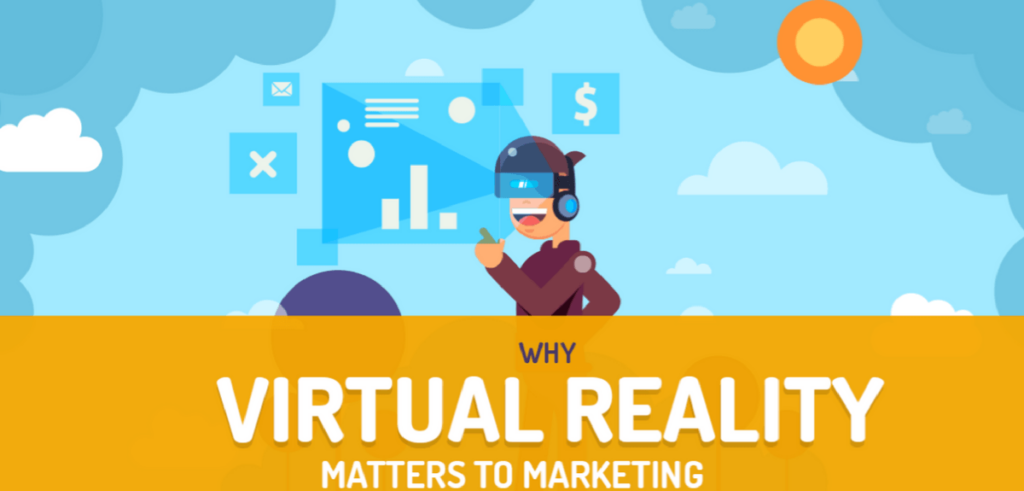-
 22 min. read
22 min. read
-
 WebFX Team
WebFX Team Digital Marketing Agency
Digital Marketing Agency
- The WebFX team is made up of more than 450 subject matter experts in digital marketing, SEO, web design and web development, social media, and more. Together, they’ve helped WebFX’s clients earn more than $3 billion in revenue from the web — and that’s just in the past five years. @webfx
Virtual reality marketing used to be an advertising pipe dream. But now, it’s all but a universal reality.
But what is virtual reality marketing? Does it really matter?
Does it have the power to change how we market online?
The short answer is yes — but the long answer is much more interesting.
It’s still experimental, but virtual reality shows incredible promise for the future — especially for marketers. To learn the basics of virtual reality marketing, check out our infographic below! 
VR marketing terminology
Before you start marketing with virtual reality, you have to know the terminology behind it.
New technology almost always brings new jargon and ideas with it, and if you don’t know them, you’ll have a hard time making the right marketing choices. These six terms are just an intro to VR marketing terminology. But they’re enough to get started on the right track.
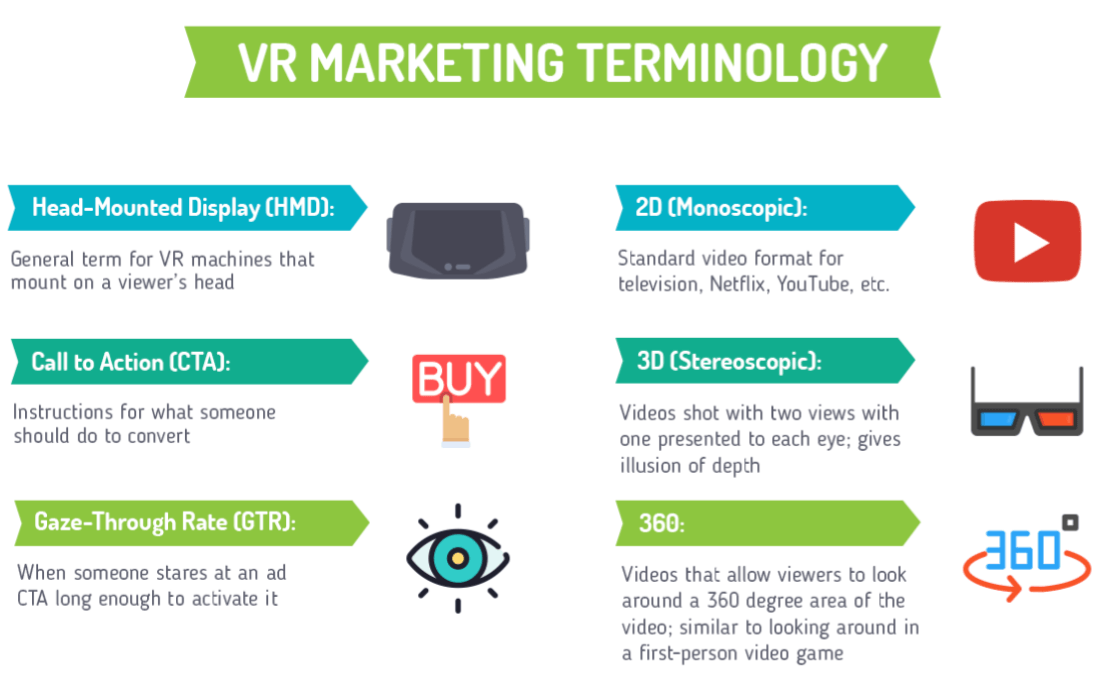
VR term #1. Head-mounted display (HMD)
First, we have head-mounted display (HMD). An HMD is a container for a VR unit or a VR unit itself, depending on how the unit is made. For example, Google produces a container for VR units called Cardboard.
Someone buys Cardboard, places their VR unit inside, and enjoys their VR experience. 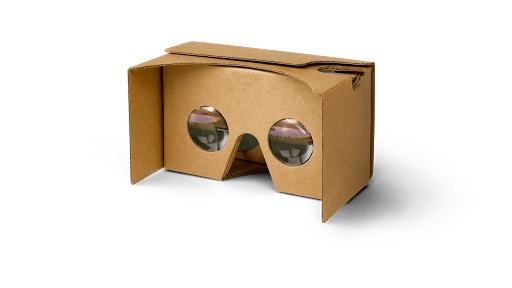 On the other hand, Oculus Rift produces self-contained HMDs. These products have the VR unit and head-mounting equipment all in one.
On the other hand, Oculus Rift produces self-contained HMDs. These products have the VR unit and head-mounting equipment all in one.
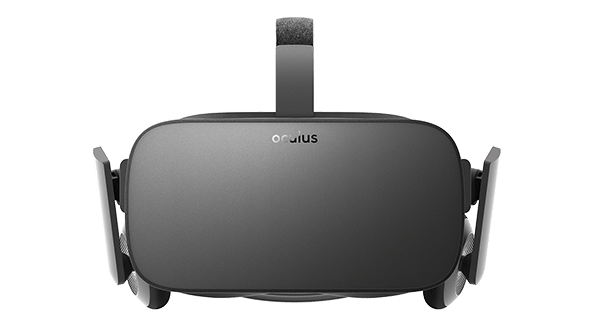 Both of these are examples of HMDs, even though they work differently. Currently, the market has lots of options for both HMD styles.
Both of these are examples of HMDs, even though they work differently. Currently, the market has lots of options for both HMD styles.
VR term #2. Call to action (CTA)
The next term we have calls to action (CTA). A CTA works the same way in VR as any other marketing format — it’s your brand telling potential customers what to do next to convert into paying customers. In conventional content marketing, your potential customers click on your CTA to convert.
But with VR, users don’t always have the option to click a mouse or a joystick. That brings us to our next VR marketing term.
VR term #3. Gaze-through rate (GTR)
Gaze-through rate (GTR) refers to the percentage of users who view your VR marketing materials and convert by looking at your CTA. Looking is critically important to GTR. Many HMDs come with eye-recognition capabilities, which let users activate different elements of a VR experience with their vision.
So instead of clicking on a CTA to activate it, VR users look at your CTA to activate it. That’s where we get the “gaze” part of GTR.
VR term #4. 2D (monoscopic)
VR is capable of providing experiences in at least two major formats. One of those formats is 2D, also called “monoscopic.” These experiences are the same that you have with the conventional computer or device screens. They’re videos, video games, or interactives that appear flat.
There aren’t any major advantages or disadvantages to this format — in fact, most of the Internet is monoscopic. But thanks to other technological breakthroughs, VR users can enjoy more than a typical 2D experience.
VR term #5. 3D (stereoscopic)
In addition to 2D experiences, VR can also render 3D (or “stereoscopic“) experiences that immerse users much more effectively than 2D. By adding the illusion of realistic depth to your VR marketing materials, you can give someone the feeling that they’re actually living in what you’ve created. That has exceptional implications for film and video games, but it can also work to the advantage of marketers.
That’s because 3D experiences work hand-in-hand with brand storytelling. Let’s say you have a page on your site with text, images, and a CTA. The goal is to get a user to read the page and convert into a lead or paying customer.
That’s great — but people have been reading pages of information for thousands of years. VR lets you take several big leaps forward. Now, let’s say you’ve created a 3D, VR-specific part of your website that is more than just text.
There, you break up the text into sections and place them at different parts of the experience. Your intro can be overhead, your first point can be on the left, and your third point could be on the right. Then, your user could zoom to different parts of your VR setup to read what they want.
Beyond that, you could even let your users walk through your VR experience to get to different parts of your page. Your into could be a starting line, your next page could be a few steps away, and your CTA could be a big, bold sign at the end. This is just one possibility of a 3D VR experience, but offering it already immerses your users much more effectively than text, graphics, or video.
Why? Because your users are living your information.
VR term #6. 360
In VR marketing, 360 refers to a user’s capability to turn their head, look somewhere else, and see something new. It requires VR marketers to create a detail-heavy experience that considers the fact that every user may look somewhere different or in a different order. In that respect, designing this kind of VR marketing experience requires a similar approach to designing a video game.
The only difference is that your “player” is a “user” instead. So in your experience, where will your “player” look first? Will you guide them to the right or left?
Is there a benefit to them following your instructions? Is there a penalty for them not following your instructions? How will a user know-how, where, and when to convert?
These — along with dozens of other questions — are all essential to creating a 360 experience in VR. If it sounds complex, you’re right. These kinds of experiences will test the absolute limits of a marketing team’s vision, a programmer’s talent, and a designer’s layout (among other professions involved).
This format of VR marketing is a long, involved process. It’ll probably be expensive, too. But providing a fully-immersive, predictive, and even rewarding marketing experience for VR users would place your brand in an entirely separate league from your competitors.
VR brands
Several major brands have already broken into the VR game.
Some of them are specifically VR platforms, while others are endeavors into new product territory for established companies. 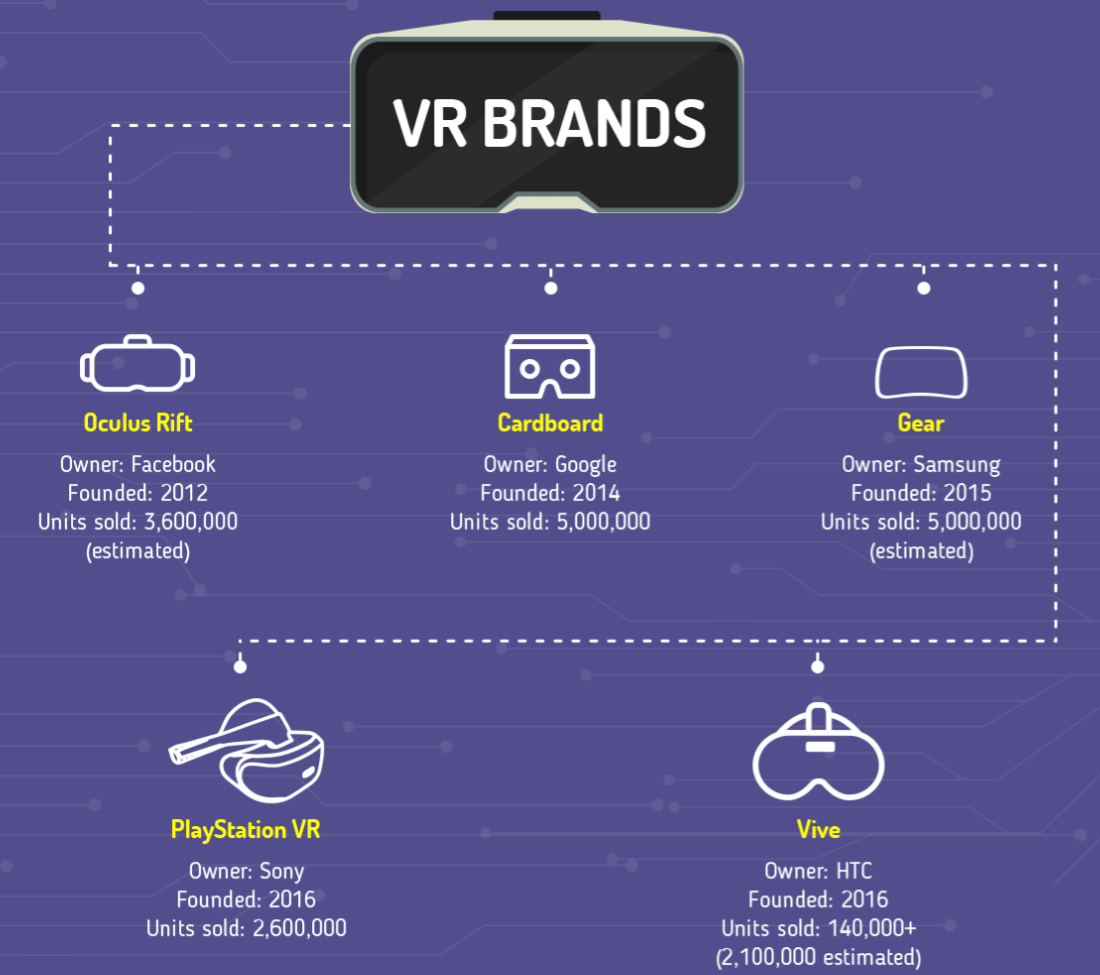
VR brand #1. Oculus Rift
Perhaps the most famous VR brand is Oculus Rift. 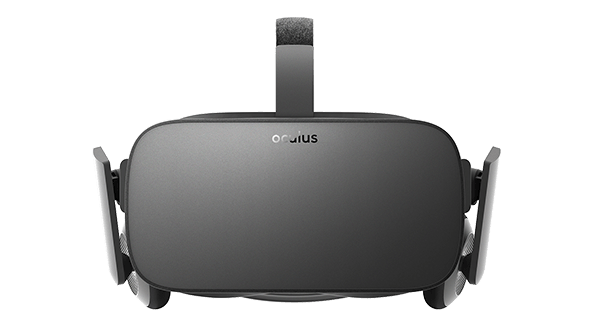 Oculus Rift was invented by Palmer Luckey, whose interest in VR drove him to create a new way for people to experience almost every kind of media. His company, Oculus VR, started a Kickstarter campaign in 2012 and raised $2.5 million.
Oculus Rift was invented by Palmer Luckey, whose interest in VR drove him to create a new way for people to experience almost every kind of media. His company, Oculus VR, started a Kickstarter campaign in 2012 and raised $2.5 million.
Two years later, Facebook bought Oculus VR for $2 billion. In that time, Oculus has inspired more companies to get into the VR industry, not to mention a colossal following of dedicated fans. Oculus Rift’s first consumer product released on March 28, 2016. It uses its own controllers, but it’s also compatible with Xbox One game controllers. It’s rumored that Mark Zuckerberg has big plans for Oculus in the future. And if Facebook starts using VR, you can bet it’ll pay dividends for marketers.
Oculus Rift uses a self-contained HMD that retails for $599.
VR brand #2. Google Cardboard
Not to be outdone by another tech giant, Google rolled out Cardboard in 2014. 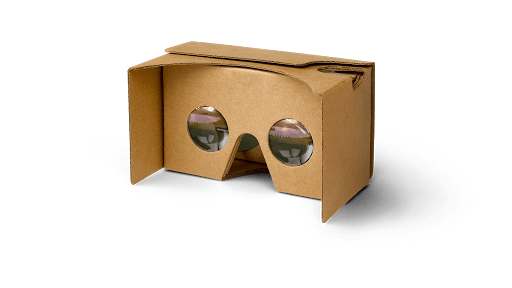 Cardboard is the name of Google’s VR app and the headset container that works with it. The Cardboard app is available on the Play Store for free and works with any Android-powered device. Google calls its initiative Cardboard because the headset is literally made out of the same material.
Cardboard is the name of Google’s VR app and the headset container that works with it. The Cardboard app is available on the Play Store for free and works with any Android-powered device. Google calls its initiative Cardboard because the headset is literally made out of the same material.
That’s because Google already has VR-compatible technology in its line of Nexus and Pixel smartphones (not to mention anything else that runs on Android). So instead of charging hundreds of dollars for a headset, Google offers a free VR app with a $15 headset. Cardboard is compatible with any VR-listed app on the Play Store and VR-compatible videos on YouTube.
That makes it a pretty reliable way to enjoy most forms of media, especially for those who enjoy online video more than conventional television. Considering YouTube already works in VR mode, a lot of YouTube ads already run on VR videos. In that case, it’s logical to expect VR ads to come through Google AdWords at some point in the future, which will probably be filmed with Google’s VR-specific camera called Jump.
This is just a prediction — but with Facebook and Google both owning a VR property, it’s probable that both will create ad options for VR in the near future.
VR brand #3. Samsung Gear
Samsung Gear is our next major VR brand even though it’s not an independent VR concept. 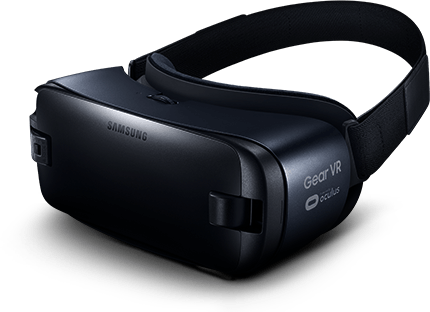 Samsung Gear is an HMD+smartphone combo that works similarly to Google Cardboard. However, Gear is actually powered by Oculus Rift.
Samsung Gear is an HMD+smartphone combo that works similarly to Google Cardboard. However, Gear is actually powered by Oculus Rift.
That means Gear is essentially Oculus Rift in another format. Instead of a self-contained HMD, it requires a compatible smartphone and app(s). Gear has a slew of high-profile names behind it that appeal to virtually (no pun intended) every audience possible.
Discovery, Minecraft, and Jaunt all offer Gear-compatible VR experiences. That’s an impressive backlog of brands, and that list will probably grow as the public adopts VR usership on a larger scale (which we’ll discuss later). Gear is made out of more solid and complicated parts than Google Cardboard, so it retails at $99. Still, if someone has a VR-compatible smartphone, this gives them a VR option that’s more affordable than Oculus while still enjoying the same brand quality.
VR brand #4. HTC Vive
HTC Vive is arguably the most diverse VR brand in terms of hardware. 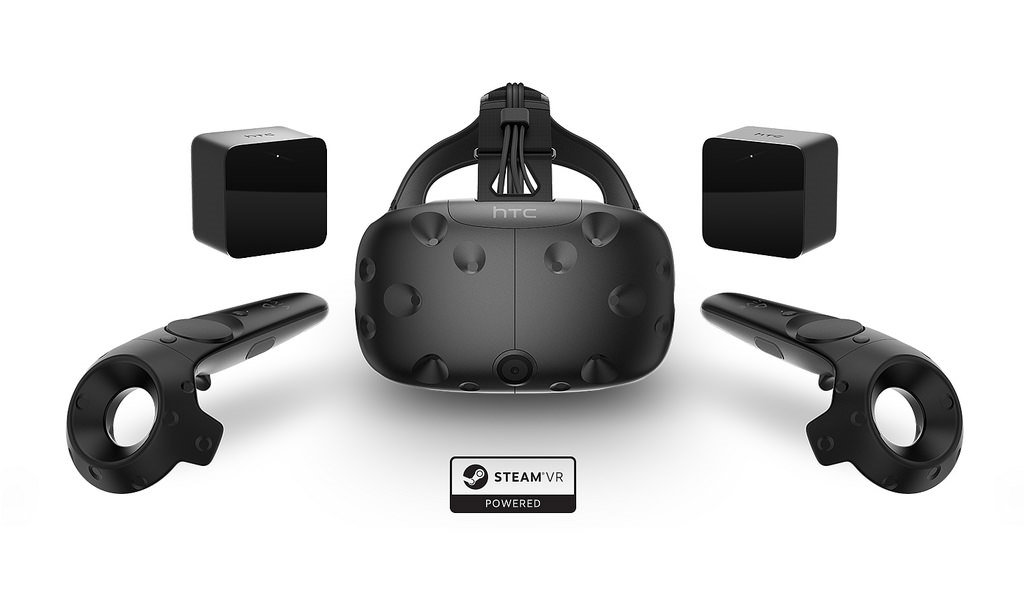 Vive has a huge catalog of VR-compatible products, including a self-contained HMD, hand-held controllers, audio-infused HMD straps, motion-tracking stations, object trackers (they incorporate real-world objects into a VR experience), and more. Vive’s primary use is video games.
Vive has a huge catalog of VR-compatible products, including a self-contained HMD, hand-held controllers, audio-infused HMD straps, motion-tracking stations, object trackers (they incorporate real-world objects into a VR experience), and more. Vive’s primary use is video games.
HTC has partnered with the wildly successful video game company Valve to use their Steam library of games. That lets Steam users play video games right in their Vive HMD. But Vive also has extensive plans for regular video, the plans for which are as varied as the hardware they offer.
With all of that in one property, Vive has laid the groundwork for a lot of online potential. But because they focus on video games so heavily, it’s less likely Vive will be used as heavily for marketing purposes when you compare it to Oculus Rift or Google Cardboard. That may steer the more hardcore VR users to Vive, but that’s a good thing.
It means when you advertise on Facebook or YouTube, you won’t have to deal with users who don’t want to see ads. You’ll only reach a qualified audience. On the other hand, its extensive suite of accessories gives Vive a huge potential that other VR brands might not be able to match.
That gives more possibilities to marketers in terms of topics, scale, and more. The Vive has a self-contained HMD that retails at $799, making it the most expensive VR headset to date.
VR brand #5. Sony PlayStation VR
PlayStation VR is Sony’s bid on the VR table. Its straightforward name tells you pretty much everything you need to know about it:
- It’s from Sony
- It requires a PlayStation
- It involves VR
The PlayStation VR self-contained HMD retails for a reasonable $399, but when you include the cost of a PlayStation 4 ($250), PlayStation Move controllers ($100 each), and PlayStation Move camera ($40), the whole bundle costs about $900. 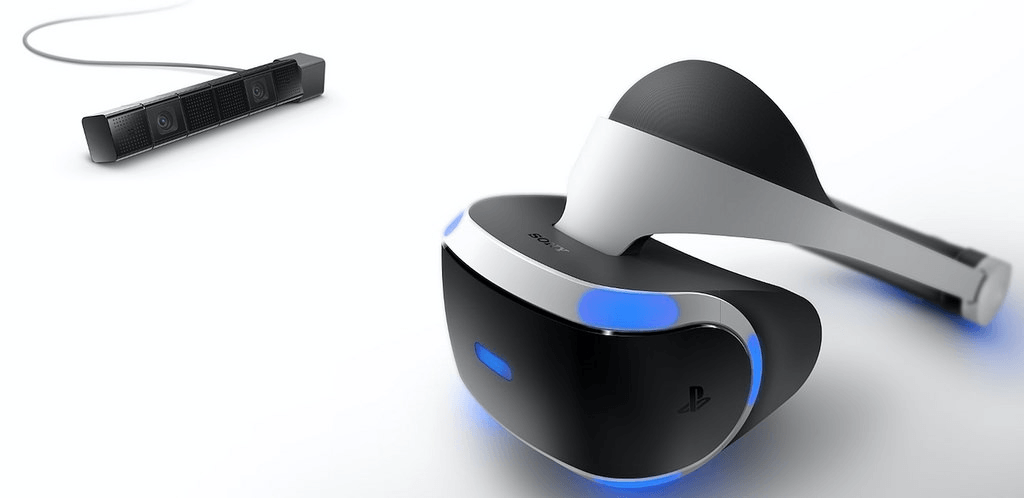 That means PlayStation is the most expensive VR system right now, but only when you include all of the other bits and pieces. That’s a heavy cost of entry for a lot of PlayStation users, which means it’s less likely people will use that over Vive, Gear, Oculus, or Cardboard. Still, that shouldn’t impact marketers too badly.
That means PlayStation is the most expensive VR system right now, but only when you include all of the other bits and pieces. That’s a heavy cost of entry for a lot of PlayStation users, which means it’s less likely people will use that over Vive, Gear, Oculus, or Cardboard. Still, that shouldn’t impact marketers too badly.
PlayStation VR is fully focused on PlayStation-compatible video games. Those don’t give a lot of opportunities for advertising if any at all. So much like the HTC Vive, PlayStation VR’s user base won’t be subject to many ads.
But that actually works out to marketers’ advantage since they don’t want to see ads in the first place. Now that we’ve covered VR brands, let’s look to see who’s actually using them.
VR adoption and mobile stats
So VR is here, but is it here to stay? According to the numbers, yes.
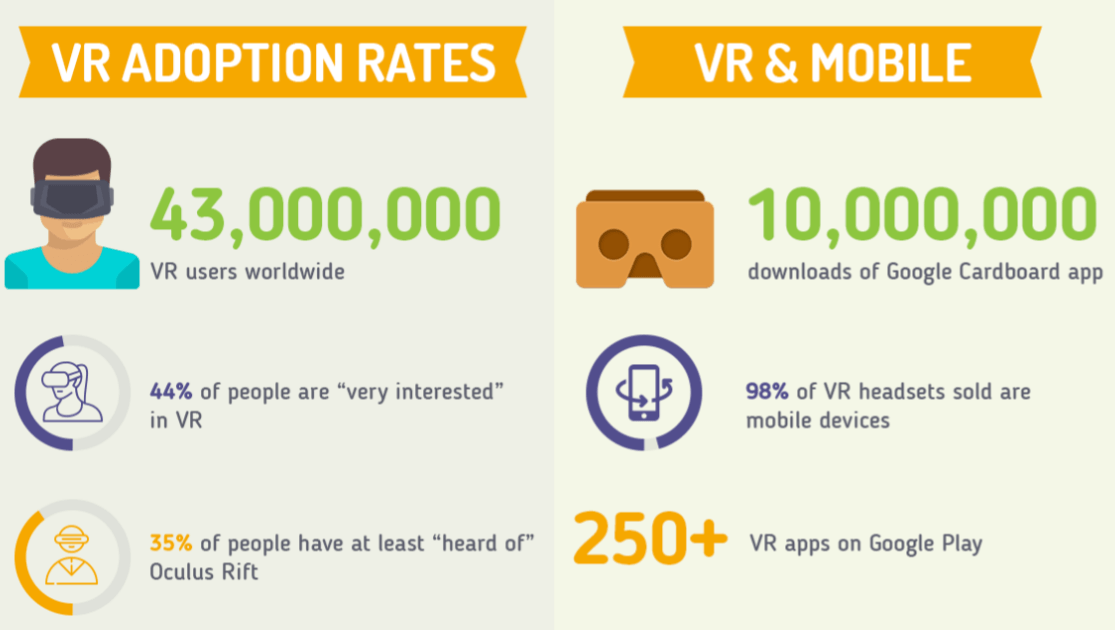 Since the release of VR headsets, the format has earned more than 43 million users worldwide. Beyond that, 44% of all people say they’re “very interested” in VR in general, and 35% have at least heard of Oculus Rift. That speaks volumes for VR adoptions as a whole, especially because it’s only been around for a few years, at the time of publication.
Since the release of VR headsets, the format has earned more than 43 million users worldwide. Beyond that, 44% of all people say they’re “very interested” in VR in general, and 35% have at least heard of Oculus Rift. That speaks volumes for VR adoptions as a whole, especially because it’s only been around for a few years, at the time of publication.
But VR has a lot of potential for mobile devices, too. Google Cardboard has more than 10 million downloads on the Play Store, and 98% of all VR headsets sold are mobile devices. It’s important to keep in mind that those mobile devices aren’t intended to be used as VR headsets all the time.
They’re just VR-compatible devices that can use VR if the user chooses. (The remaining 2% of devices are VR-specific HMDs.) Finally, VR is moving forward at a surprising pace for mobile devices. The Play Store already has more than 250 VR-compatible apps listed on it, many of which are free.
With all of this considered, VR probably isn’t going to be a flash in the pan. But what value can it actually offer marketers?
VR, mobile, and desktop ads
In a nutshell, VR advertising is significantly more effective than mobile or desktop advertising. The reason isn’t 100% clear, but it’s most likely because of the immersive nature of VR.
Still, how much better does VR work than mobile and desktop ads? 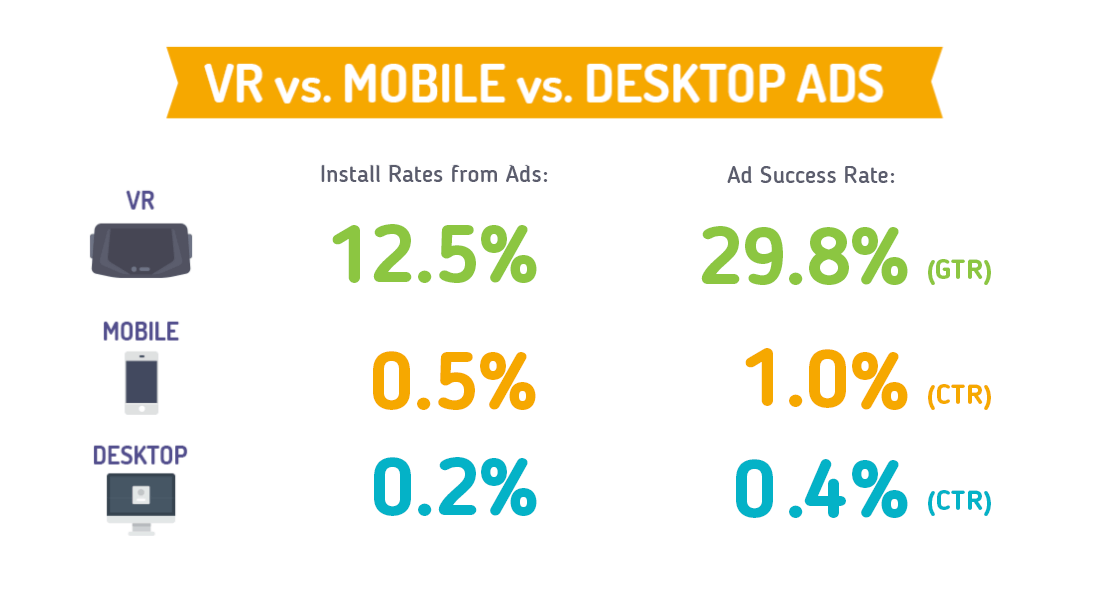 When it comes to installing programs from ads, VR is worlds ahead of mobile and desktop capabilities. A 12.5% success rate for ad installs is absolutely unprecedented.
When it comes to installing programs from ads, VR is worlds ahead of mobile and desktop capabilities. A 12.5% success rate for ad installs is absolutely unprecedented.
But even that pales in comparison to the general success rate of VR ads. In this context, “success rate” refers to a user acting on the CTA of an ad. VR earned a 29.8% overall ad success rate, which is the stuff of legend.
That means for every three people who saw a VR ad, one of them followed the CTA. That’s a colossal improvement over the celebrated successes of mobile and desktop ads, which hover around 1% and 0.4%, respectively. So it’s a fact — VR ads are outrageously successful.
But how many people will actually see your ads if you list them in VR?
VR users by year
To get an idea for your ad audience, let’s take a look at the number of VR users every year. We’ve already talked about how many VR users there were in 2016. But that doesn’t account for the explosive growth that VR has experienced. 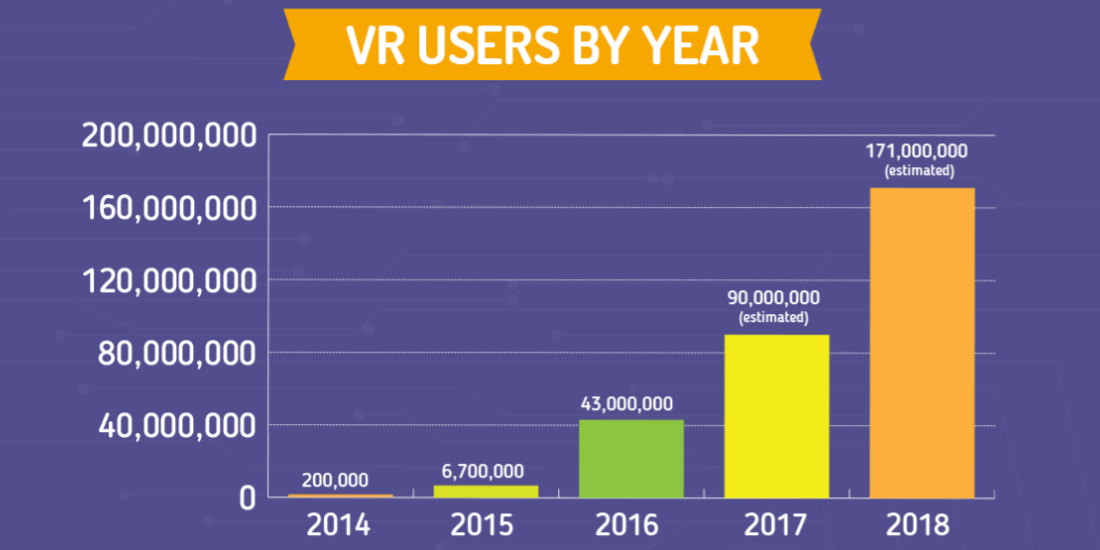 In 2014, as VR was just emerging as an entertainment medium, only 200,000 people used it. In 2016, there were 43 million.
In 2014, as VR was just emerging as an entertainment medium, only 200,000 people used it. In 2016, there were 43 million.
That’s an increase of 21,500%. If VR were an illness, it’d be a pandemic. By 2018, VR users are expected to expand by an additional 397% to 171 million people.
That’s an incredible market worldwide consisting of everyone from gamers on PS4 to cat-video enthusiasts on YouTube. With such a huge audience, it’d be crazy not to invest in VR marketing. But how has VR caught on so quickly?
And why is it expected to grow so rapidly?
VR marketing stats
VR has become so popular for one big reason. Because it’s cool. VR is so cool, in fact, that most people can’t stop talking about it.
Even the people who don’t use it really want to at some point in the future. 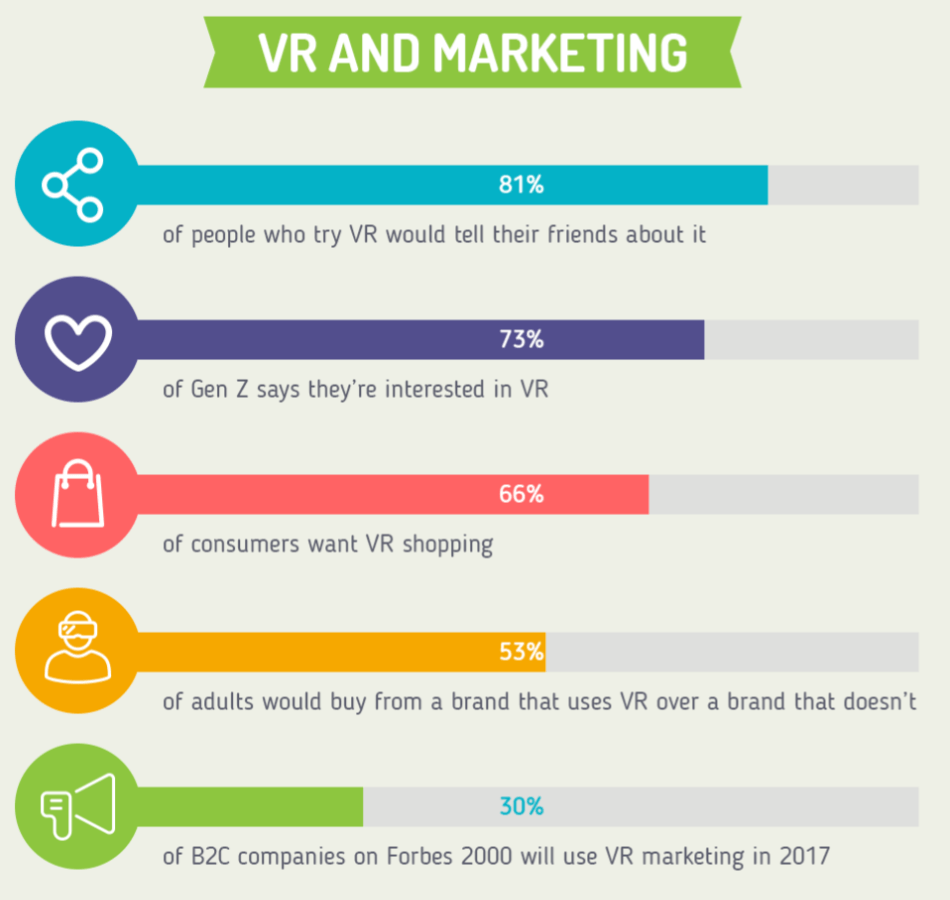 First, 81% of people who try VR wind up telling their friends about it. That’s huge since word of mouth is still one of the most effective forms of marketing.
First, 81% of people who try VR wind up telling their friends about it. That’s huge since word of mouth is still one of the most effective forms of marketing.
So when you choose to market your business via VR, you’re not just marketing to the end-user. For 4/5 people, they’re going to tell their friends about their experience. Next, 73% of Generation Z (the generation after Millennials) says they’re interested in VR.
That up-and-coming market will be in the workforce over the next few years, meaning they’ll have the disposable income to participate in VR and buy your products. On top of that, 66% of all consumers want VR shopping. That opens the doors to entirely new forms of marketing with Amazon, Overstock, and other online retailers converting into VR experiences.
Another key stat — 53% of adults would buy from a brand that uses VR over a brand that doesn’t. So when you incorporate VR into your company’s marketing strategy, you’re already earning the favor of 53% of adults. That gives you a huge lead over your competitors who don’t use VR.
Last, the VR marketing revolution is already happening. 30% of B2C companies on Forbes 2000 will use VR marketing
. If you want to keep up with the trailblazers, you should adopt VR marketing too. But there’s still one big question — what would you do with VR marketing to get new customers?
VR marketing strengths
VR marketing is sure to have its fair share of advantages.
So far, marketing has identified three big ones. 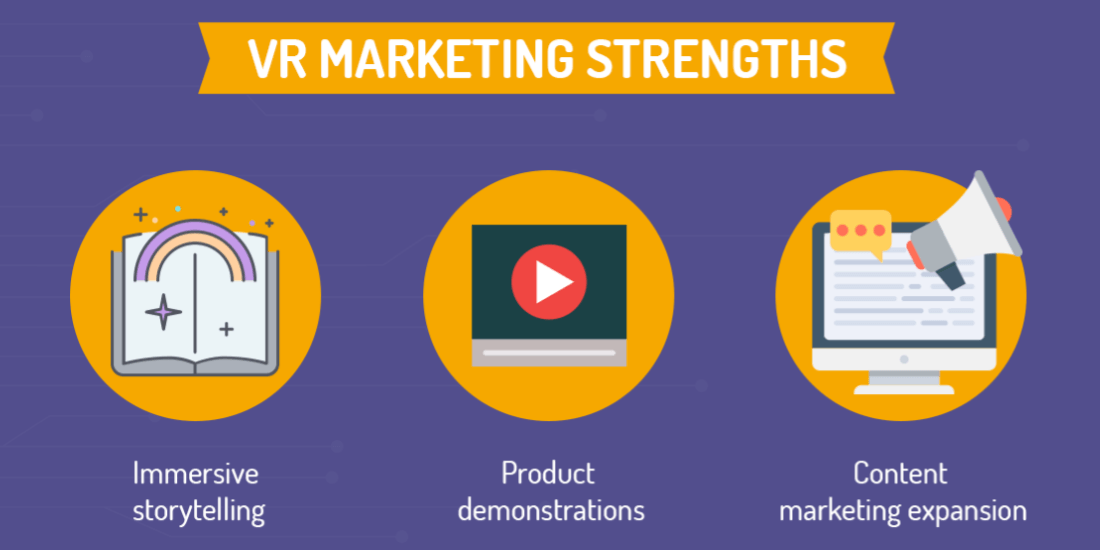 Immersive storytelling is a no-brainer. That’s what VR video games accomplish, and that’s why there are VR brands exclusive to video games.
Immersive storytelling is a no-brainer. That’s what VR video games accomplish, and that’s why there are VR brands exclusive to video games.
People want to experience stories in a new way. They don’t want to read about a hero. They don’t want to watch a hero.
They don’t want to play the part of a hero. They want to be the hero. While they’re participating in a story, VR offers a level of immersion that’s unmatched by other media.
That means there aren’t any cues from reality to snap someone out of their story. There aren’t windows, noises, or any other distractions. There’s only the story.
Aside from storytelling, VR offers an incredible new dimension to product demonstrations. Think about any product in the world. Today, you have to read about it or watch a video of it in action.
But what if you could get your hands on it before you bought it? With VR, manufacturers and retailers can let anyone get their hands on whatever they want. That includes everything from a plush elephant to mining machinery.
That means mining companies can train their employees before sending them into the rock. Airlines can test their pilots more thoroughly in demos that are indistinguishable from real life. Firefighters can run simulations without the risk of losing someone to mistakes.
The possibilities for demonstrations are endless. They’ll allow anyone to vicariously experience just about anything in the world. Finally, innovations in VR have created a new branch of content marketing.
It’s not 100% video. It’s not 100% text. It’s something else entirely.
VR interactivity promises to take the Internet (and marketing in general) to new places. The only limit is the imagination of the marketer. But these three ideas are all well and good.
Do they actually work?
VR brand successes
Brands have already experienced success using VR, even at such an early phase in VR’s lifetime. 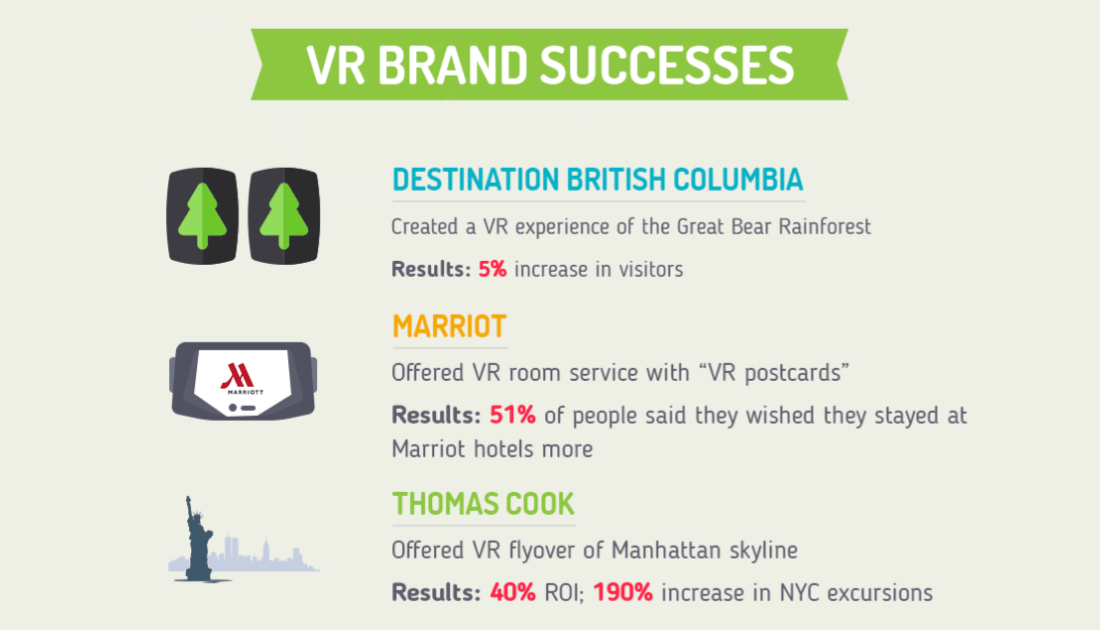 Destination British Columbia found success with VR by creating an artificial experience of the Great Bear Rainforest, which is on Canada’s Pacific Coast. Called “The Wild Within,” the VR experience earned a 5% increase in tourism to the destination.
Destination British Columbia found success with VR by creating an artificial experience of the Great Bear Rainforest, which is on Canada’s Pacific Coast. Called “The Wild Within,” the VR experience earned a 5% increase in tourism to the destination.
That may not sound like much — but keep in mind that that increase came from one piece of VR marketing. The experience is also available in traditional video, which you can see on the company’s YouTube channel. Marriot started using “VR postcards” that let travelers send short, immersive clips of their area to others.
These postcards are designed to give someone a taste of the travel experience for free, which will hopefully entice viewers to travel more — and stay at Marriot hotels. The strategy worked. In a survey about the postcards, 51% of respondents said they wished they stayed at Marriot hotels more often.
Thomas Cook started an initiative to become a virtual travel agent, filming the Manhattan skyline so viewers can see it as someone in a helicopter. It was a simple plan, and it worked phenomenally well. Thomas Cook saw 40% ROI from the project with a 190% increase in trips to New York City.
That means the verdict is in — VR marketing indisputably works. In fact, it works a lot better than many other forms of marketing. So what’s in store for VR in the future?
And how much will it be worth?
Future of VR
According to Goldman Sachs, VR has the potential to become a multi-billion dollar industry. In fact, the biggest facets of VR will be worth billions all on their own. 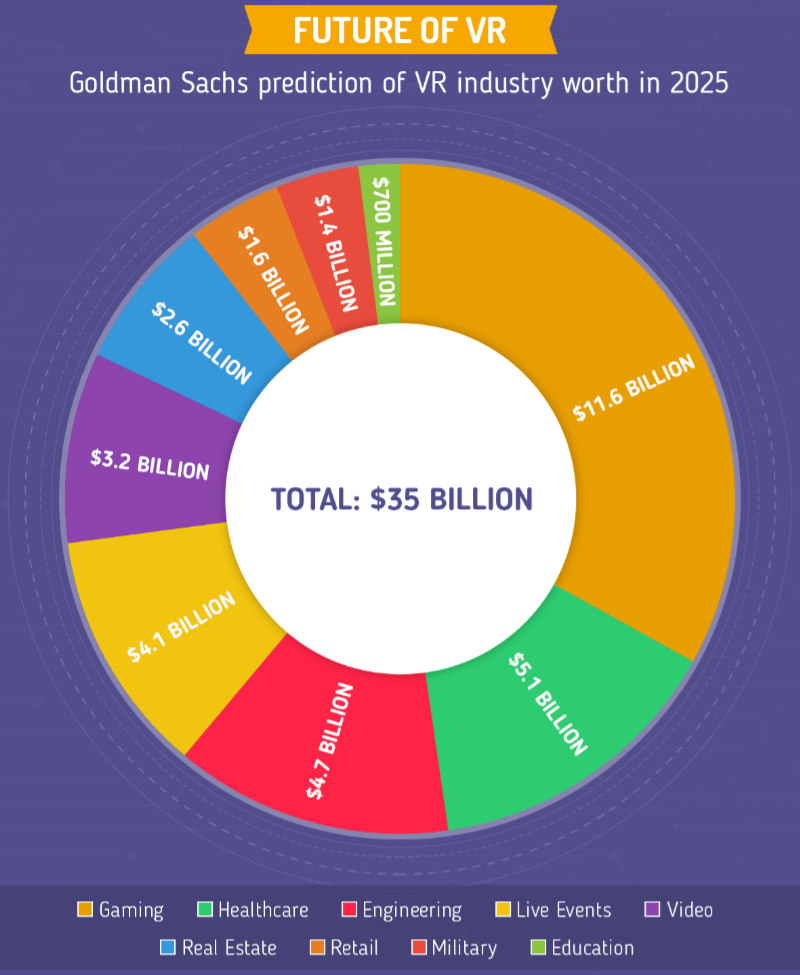 This chart is pretty telling.
This chart is pretty telling.
That’s a lot of money for one technology. But while we respect the vision of Goldman Sachs in their prediction, we disagree on the value of retail by 2025. 2025 is currently eight years out from the date we published this infographic. We’re guessing VR retail will be worth substantially more than $1.6 billion. In fact, we wouldn’t be surprised if it surpassed video games at $12 or $13 billion.
Why? Because given the rates of VR adoption, VR ad successes, and past VR brand success stories, the world is going to use VR en masse in no time. Considering big retail brands like Amazon like to stay on top of future tech, we wouldn’t be surprised if they had a VR experience lined up already.
And if that’s the case, Amazon will add an entirely new dimension to online shopping that’s sure to change how people buy. And when that happens, Amazon’s competitors (and imitators) will follow. Beyond estimated worth, VR has two more promising predictions just based on economic trends.
 Because VR has a healthy diversity of brands, prices will eventually drop. That means more affordable hardware and software all around. Plus, as technology is used more, the price tends to drop anyway.
Because VR has a healthy diversity of brands, prices will eventually drop. That means more affordable hardware and software all around. Plus, as technology is used more, the price tends to drop anyway.
So the future is promising when it comes to affordable VR products. Second, VR brands will probably consolidate after the prices drop. We see this in technology frequently, even with common industries.
The top companies will shoot to acquire others to eliminate competition and earn new talent. With that in mind, any popular VR brand has a promising future as a major competitor in a new field. Only time will tell the winner.
Help others stay on the cutting edge of VR
Did you learn something new about VR?
Help others learn too! VR has the potential to change the world, and that includes marketing. Post this infographic to your own site to get the word out!
VR is here, and it’s growing every day!
-
 The WebFX team is made up of more than 450 subject matter experts in digital marketing, SEO, web design and web development, social media, and more. Together, they’ve helped WebFX’s clients earn more than $3 billion in revenue from the web — and that’s just in the past five years.@webfx
The WebFX team is made up of more than 450 subject matter experts in digital marketing, SEO, web design and web development, social media, and more. Together, they’ve helped WebFX’s clients earn more than $3 billion in revenue from the web — and that’s just in the past five years.@webfx -

WebFX is a full-service marketing agency with 1,100+ client reviews and a 4.9-star rating on Clutch! Find out how our expert team and revenue-accelerating tech can drive results for you! Learn more
Try our free Marketing Calculator
Craft a tailored online marketing strategy! Utilize our free Internet marketing calculator for a custom plan based on your location, reach, timeframe, and budget.
Plan Your Marketing Budget

Maximize Your Marketing ROI
Claim your free eBook packed with proven strategies to boost your marketing efforts.
Get the GuideTry our free Marketing Calculator
Craft a tailored online marketing strategy! Utilize our free Internet marketing calculator for a custom plan based on your location, reach, timeframe, and budget.
Plan Your Marketing Budget

